Maternity Hospital
Maternity
It is claimed that this is the oldest maternity hospital in the country, originating in a house in Jermyn Street and established in 1739 by Sir Richard Manningham (1690-1759), the leading man-midwife (obstetrician) of his day. It had 25 beds.
However, it is generally accepted that the hospital began as the General Lying-In Hospital and was established in 1752, founded by Felix Macdonogh, making it the third oldest maternity hospital after the one in Brownlow Street (1749), which later became the British Lying-In-Hospital, and the City of London Lying-In Hospital (1750).
The Hospital soon moved from Jermyn Street to St George's Row (later renamed Hyde Park Place), near the Tyburn turnpike, then to Duke Street, Grosvenor Square, in 1754. In 1762 it moved to Quebec Street in St Marylebone, then back to St George's Row in 1773. In 1791 it moved to Bayswater Gate, near Queens Road, where it secured the support of the Duke of Sussex.Intended for the poor (the rich were attended to in their own homes), the Hospital admitted both married and single women, an unusual arrangement at the time as lying-in hospitals usually only cared for married women. Single women were only admitted for their first baby (penitent women were not admitted a second time). Out-patients were also seen, especially the wives of soldiers or sailors. The Hospital accepted resident midwifery pupils, but these were all male.
In 1809 the Hospital underwent a reorganisation. It was renamed Queen Charlotte's Lying-In Hospital, taking its name from Queen Charlotte (1744-1818), the wife of King George III. The Duke of Sussex, her son, had persuaded her to give her name to the Hospital.
In 1813 the Hospital moved again, to the Old Manor House, Lisson Green, on the corner of Harcourt Street and the New Road (part of which was later renamed Old Marylebone Road). The Manor House, which had three floors and a basement, had been bought for £2120, including £125 for the fixtures.By the mid 1850s the building had become too small for the demand on its services. Plans were made for a complete rebuilding. Temporary premises were rented at Middlesex Place at the cost of £50 per year and, in 1855, on Michaelmas Day (29th September) the Hospital was vacated. The first stone for the new building was laid on 15th November and the 3-storey building completed in September 1856 at a cost of £4454. It opened for admissions in 1857.
Capable of accommodating 50 patients, only 30 beds were available because of financial restrictions. The first and second floors each held six lying-in wards of three beds each, with a convalescent ward of six beds. Each floor contained a bathroom.
By 1865 the need was felt again for larger premises. The Hospital closed in August while an extra storey was added, at a cost of £1000.
In 1872 the first resident Medical Officer was appointed and, soon afterwards, a Matron (up to this time a resident midwife had been in charge of the patients). In 1878 a new wing was added to the building and, in 1897, a labour ward (previously, mothers had given birth in the lying-in wards).
A convalescent home opened in 1882 at 20 Victoria Road, Kilburn. Another wing was added to the Hospital in 1885 and was officially opened in 1886 by the Prince and Princess of Wales (the wing was further enlarged in 1899).
In 1899 a Nurses' Home and Residential College was built at 268 Marylebone Road, and was extended in 1908 (the extension was officially opened by Princess Alexandra of Teck). The Hospital also provided an Infant Consultation Centre at 12 Harcourt Street.
In 1921 many of the wards were reconstructed. The name of the Hospital was changed to Queen Charlotte's Maternity Hospital in 1923. A new operating theatre was built in 1926.
In 1927 an appeal was launched for the rebuilding of the Hospital (£150,000 was needed) and, in 1928, a 5-acre site was purchased in Hammersmith for what was to be a maternity hospital with 300-350 beds.
In 1929, when the Hospital had 80 beds, building work began on the new site in Goldhawk Road, with the foundation stone for an isolation block being laid in November by Princess Marie Louise, standing in for Princess Mary who had been prevented from doing so by a recent bereavement.
The isolation block was completed in 1931 but the Hospital continued to function on both sites, with some in-patient beds in one of the existing villas in Goldhawk Road. The Hospital had 130 beds, that is, 80 at the Marylebone Road site and 20 at Goldhawk Road, with 30 in the isolation block. At this time the cost of an in-patient per week was £4 16s 6d (£4.82) in the main beds, but £10 6s 8d (£10.33) in the isolation block. By 1936 the comparative costs had fallen to £4 12s 6d (£4.62) in the main Hospital and £8 15s 0d (£8.75) in the isolation wards.
Building work recommenced on the Hammersmith site in 1937 and the first ward block was completed in 1939. The Nurses' Home was half-built just as WW2 was declared, but nonetheless the Hospital moved to its new buildings in 1940.
Present status (January 2010)
In 1948 the Marylebone Road building was bought by St Dunstan's (now Blind Veterans) for use as its headquarters. The site has since been redeveloped and today contains a large modern office building.
The Nurses' Home was sold to the Church Army.
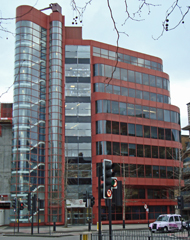
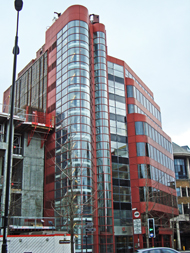
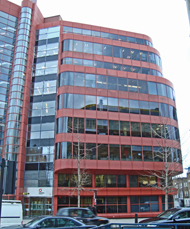
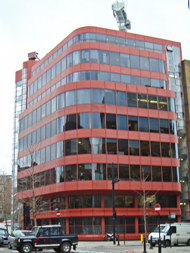
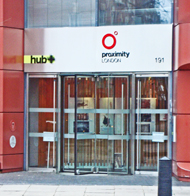
191 Old Marylebone Road
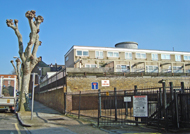
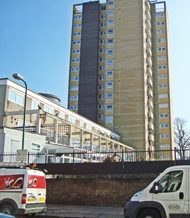
The convalescent home in Victoria Road has long been replaced by the Kilburn Square housing estate.
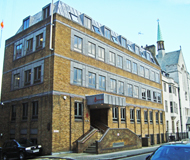
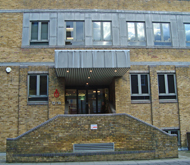
The Infant Consultation Centre in Harcourt Street is now the headquarters for St Dunstan's.


The former Nurses' Home is now the Church Army building.
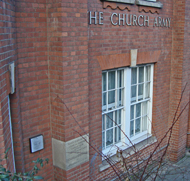
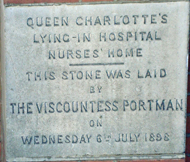
The foundation stone at the corner of the building.
The Hospital also provided a district midwifery service to deliver patients in their own homes. By the 1930s the areas covered had increased and extended from St Pancras and Willesden to Ealing and Wandsworth.
Dewhurst J 1987 Felix Macdonogh, man-midwife. Paragon or charlatan? Journal of Obstetrics & Gynaecology 8, 99-103.
Ryan T 1885 The History of Queen Charlotte's Lying-In Hospital. Published by the Hospital.
http://wellcomecollection.org
www.aim25.ac.uk
www.pastscape.org.uk (1)
www.pastscape.org.uk (2)
www.pastscape.org.uk (3)
www.ply.me.uk
Return to home page